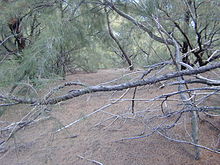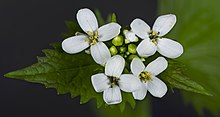Allelopathy

Allelopathy is a biological phenomenon by which an organism produces one or more
Allelopathic interactions are an important factor in determining
It can often be difficult in practice to distinguish allelopathy from resource competition. While the former is caused by the addition of a harmful chemical agent to the environment, the latter is caused by the removal of essential nutrients (or water). Often, both mechanisms can act simultaneously. Moreover, some allelochemicals may function by reducing nutrient availability. Further confounding the issue, the production of allelochemicals can itself be affected by environmental factors such as nutrient availability, temperature and pH. Today, most ecologists recognize the existence of allelopathy, however many particular cases remain controversial.
History
The term allelopathy from the
Long before the term allelopathy was used, people observed the negative effects that one plant could have on another.
Allelopathy is not universally accepted among ecologists. Many have argued that its effects cannot be distinguished from the exploitation
Some high profile work on allelopathy has been mired in controversy. For example, the discovery that (-)-
Examples

Plants
Many invasive plant species interfere with native plants through allelopathy.[19][20] A famous case of purported allelopathy is in desert shrubs. One of the most widely known early examples was Salvia leucophylla, because it was on the cover of the journal Science in 1964.[21] Bare zones around the shrubs were hypothesized to be caused by volatile terpenes emitted by the shrubs. However, like many allelopathy studies, it was based on artificial lab experiments and unwarranted extrapolations to natural ecosystems. In 1970, Science published a study where caging the shrubs to exclude rodents and birds allowed grass to grow in the bare zones.[22] A detailed history of this story can be found in Halsey 2004.[23]
Allelopathy has been shown to play a crucial role in forests, influencing the composition of the vegetation growth, and also provides an explanation for the patterns of forest regeneration.
Another example of allelopathy is seen in Leucaena leucocephala, known as the miracle tree. This plant contains toxic amino acids that inhibit other plants’ growth but not its own species growth. Different crops react differently to these allelochemicals, so wheat yield decreases, while rice increases in the presence of L. leucocephala.[30][unreliable source?]
Capsaicin is an allelochemical found in many peppers that are cultivated by humans as a spice/food source.[31] It is considered an allelochemical because it is not required for plant growth and survival, but instead deters herbivores and prevents other plants from sprouting in its immediate vicinity.[32][dubious ] Among the plants it has been studied on are grasses, lettuce, and alfalfa, and on average, it will inhibit the growth of these plants by about 50%.[32] Capsaicin has been shown to deter both herbivores and certain parasites’ performance.[33] Herbivores such as caterpillars show decreased development when fed a diet high in capsaicin.
Applications
Allelochemicals are a useful tool in sustainable farming due to their ability to control weeds.
Many crop cultivars show strong allelopathic properties, of which rice (Oryza sativa) has been most studied.[43][44][45] Rice allelopathy depends on variety and origin: Japonica rice is more allelopathic than Indica and Japonica-Indica hybrid.[citation needed] More recently, critical review on rice allelopathy and the possibility for weed management reported that allelopathic characteristics in rice are quantitatively inherited and several allelopathy-involved traits have been identified.[46] The use of allelochemicals in agriculture provide for a more environmentally friendly approach to weed control, as they do not leave behind residues.[34] Currently used pesticides and herbicides leak into waterways and result in unsafe water qualities. This problem could be eliminated or significantly reduced by using allelochemicals instead of harsh herbicides. The use of cover crops also results in less soil erosion and lessens the need for nitrogen heavy fertilizers.[47]
See also
- Forest pathology
- Allomone
- Phytochemical
- Semiochemical
References
- S2CID 10285393.
- ^ ISBN 978-1-4020-4092-4. Retrieved 2009-08-12.
- ISBN 978-1-4020-4279-9
- S2CID 4032046.
- PMID 5541160. Retrieved 2020-10-20.
- ISBN 978-0-12-587058-0
- ISBN 978-1-4020-4279-9
- ^ Liu D and Lovett J (1994) Biologically active secondary metabolites of barley I Developing techniques and assessing allelopathy in barley Journal of Chemical Ecology 19:2217-2230.
- ^ Liu D and Lovett J (1994) Biologically active secondary metabolites of barley. II. Phytotoxicity of barley allelochemicals Journal of Chemical Ecology 19:2231-2244.
- S2CID 21769652.
- PMID 18208469.
- ^ a b Yoon, Carol Kaesuk (2003-09-09). "Forensic Botanists Find the Lethal Weapon of a Killer Weed - The New York Times". New York Times. Archived from the original on 2019-12-12. Retrieved 2020-11-29.
- ^ Brendan Borrell. "NSF investigation of high-profile plant retractions ends in two debarments". Retraction Watch. Retrieved 29 November 2020.
- ^ Shannon Palus (3 March 2016). "Sample tampering leads to plant scientist's 7th retraction". Retraction Watch. Retrieved 29 November 2020.
- ^ Science, A. A. for the A. of. 2010. Corrections and Clarifications. Science 327:781–781. American Association for the Advancement of Science.
- ^ Perry, L. G., G. C. Thelen, W. M. Ridenour, R. M. Callaway, M. W. Paschke, and J. M. Vivanco. 2007. Concentrations of the Allelochemical (+/-)-catechin IN Centaurea maculosa soils. J Chem Ecol 33:2337–2344.
- ^ a b Duke, S. O., F. E. Dayan, J. Bajsa, K. M. Meepagala, R. A. Hufbauer, and A. C. Blair. 2009. The case against (–)-catechin involvement in allelopathy of Centaurea stoebe (spotted knapweed). Plant Signaling & Behavior 4:422–424. Taylor & Francis.
- ^ Douglass, Cameron H., Leslie A. Weston, and David Wolfe. 2011. Phytotoxicity and Potential Allelopathy in Pale (Cynanchum rossicum) and Black swallowwort (C. nigrum) Invasive Plant Science and Management 4(1):133-141
- ^ Muller, C.H., Muller, W.H. and Haines, B.L. 1964. Volatile growth inhibitors produced by aromatic shrubs. Science 143: 471-473. [1]
- ^ Bartholomew, B. 1970. Bare zone between California shrub and grassland communities: The role of animals. Science 170: 1210-1212. [2]
- ^ Halsey, R.W. 2004. In search of allelopathy: An eco-historical view of the investigation of chemical inhibition in California coastal sage scrub and chamise chaparral. Journal of the Torrey Botanical Society 131: 343-367. The California Chaparral Institute also offers a PDF-format version of this paper. [3]
- ^ Stinson, K.A., Campbell, S.A., Powell, J.R., Wolfe, B.E., Callaway, R.M., Thelen, G.C., Hallett, S.G., Prati, D., and Klironomos, J.N. 2006. Invasive plant suppresses the growth of native tree seedlings by disrupting belowground mutualisms. PLoS Biology [4]
- ^ Cipollini, D. 2016. A review of garlic mustard (Alliaria petiolata, Brassicaceae) as an allelopathic plant. tbot 143:339–348. Torrey Botanical Society.
- PMID 26635845.
- ^ Chalker-Scott, Linda (March 2, 2019). "Do black walnut trees have allelopathic effects on other plants?".
- ^ K. Sasikumar, C.Vijayalakshmi and K.T. Parthiban 2001. Allelopathic effects of four eucalyptus species on redgram (Cajanus cajan L.)
- S2CID 1145444.
- )
- S2CID 243863172.
- ^ S2CID 12936511.
- PMID 35221844.
- ^ S2CID 234111406, retrieved 2022-06-08
- ^ Kong, C.H., Li, H.B., Hu, F., Xu, X.H., Wang, P., 2006. Allelochemicals released by rice roots and residues in soil. Plant and Soil, 288: 47-56.
- .
- ^ Kong, C.H., Hu, F., Wang, P., Wu, J.L., 2008. Effect of allelopathic rice varieties combined with cultural management options on paddy field weeds. Pest management Science, 64: 276-282.
- ^ Chen, X.H., Hu, F., Kong, C.H., 2008. Varietal improvement in rice allelopathy. Allelopathy Journal, 22: 379-384.
- ^ Kaiser, Jerry (January 2016). "Allelopathy and Cover Crops" (PDF). nrcs.usda.gov. Retrieved 8 June 2022.
- PMID 26635845.
- ^ Cornes, D. 2005. Callisto: a very successful maize herbicide inspired by allelochemistry. Proceedings of the Fourth World Congress on Allelopathy [5]
- .
- .
- .
- ^ "Cover Crops - Keeping Soil in Place While Providing Other Benefits". nrcs.usda.gov. Retrieved 8 June 2022.
Further reading
- anon. (Inderjit). 2002. Multifaceted approach to study allelochemicals in an ecosystem. In: Allelopathy, from Molecules to Ecosystems, M.J. Reigosa and N. Pedrol, Eds. Science Publishers, Enfield, New Hampshire.
- Bhowmick N, Mani A, Hayat A (2016), "Allelopathic effect of litchi leaf extract on seed germination of Pea and lafa", Journal of Agricultural Engineering and Food Technology, 3 (3): 233-235.
- Blum U, Shafer SR, Lehman ME (1999), "Evidence for inhibitory allelopathic interactions involving phenolic acids in field soils: concepts vs. an experimental model", Critical Reviews in Plant Sciences, 18 (5): 673–693, .
- Einhellig, F.A. 2002. The physiology of allelochemical action: clues and views. In: Allelopathy, from Molecules to Ecosystems, M.J. Reigosa and N. Pedrol, Eds. Science Publishers, Enfield, New Hampshire.
- Harper, J. L. 1977. Population Biology of Plants. Academic Press, London.
- Jose S. 2002. Black walnut allelopathy: current state of the science. In: Chemical Ecology of Plants: Allelopathy in aquatic and terrestrial ecosystems, A. U. Mallik and anon. (Inderjit), Eds. Birkhauser Verlag, Basel, Switzerland.
- Mallik, A. U. and anon. (Inderjit). 2002. Problems and prospects in the study of plant allelochemicals: a brief introduction. In: Chemical Ecology of Plants: Allelopathy in aquatic and terrestrial ecosystems, Mallik, A.U. and anon., Eds. Birkhauser Verlag, Basel, Switzerland.
- Muller CH (1966), "The role of chemical inhibition (allelopathy) in vegetational composition", Bulletin of the Torrey Botanical Club, 93 (5): 332–351, JSTOR 2483447.
- Reigosa, M. J., N. Pedrol, A. M. Sanchez-Moreiras, and L. Gonzales. 2002. Stress and allelopathy. In: Allelopathy, from Molecules to Ecosystems, M.J. Reigosa and N. Pedrol, Eds. Science Publishers, Enfield, New Hampshire.
- Rice, E.L. 1974. Allelopathy. Academic Press, New York.
- Sheeja B.D. 1993. Allelopathic effects of Eupatorium odoratum L. and Lantana camara, L. on four major crops. M. Phil dissertation submitted to Manonmaniam Sundaranar University, Tirunelveli.
- Webster 1983. Webster's Ninth New Collegiate Dictionary. Merriam-Webster, Inc., Springfield, Mass.
- Willis, R. J. (1985), "The historical bases of the concept of allelopathy", Journal of the History of Biology, 18: 71–102, S2CID 83639846.
- Willis, R. J. 1999. Australian studies on allelopathy in Eucalyptus: a review. In: Principles and practices in plant ecology: Allelochemical interactions, anon. (Inderjit), K.M.M. Dakshini, and C.L. Foy, Eds. CRC Press, and Boca Raton, FL.
- JSTOR 2401406
